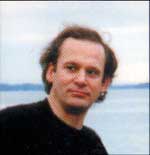River Voyage Over
The end of phase one was in sight. The river trended
southeast, then east. Human presence was heavier now, but natural
beauty did not suffer greatly. Snowy egrets still hunched like
hoodlums in the silent dawn. They faced the new sun, which cast
a violet over their plumage. The kingfisher still stood on his
overhanging branch, looking like a naval officer with a punk
hairdo. Swallows flitted over the river at sunset just as they
had back in Alberta. The sand looked like brown sugar. Rains
had loaded the river with debris. The winter rise had started.
 Levees
now pressed tightly on the river, eliminating islands and bayous.
Like an ant on basketball court, I picked my way through work
boats, tows of all sizes, and ocean freighters. The freighters
went faster, but at least they parted the water instead of steam
rolling over it, like the tows. They were tall and shapely after
the squat barges. The names, painted on bow and stern, evoked
all the seven seas: Pacifico Mexicano, Singa Sailor, Golden
Crown, Sunny Clipper, Capetan Lefteris. They hailed from Manila,
Singapore, Panama, Limassol, Oslo, and from ports unintelligible
because written in Greek or Russian. Most were high in the water,
bulbous bows half awash. Those heading out to sea floated deeper,
their holds full of oil and grain.
Levees
now pressed tightly on the river, eliminating islands and bayous.
Like an ant on basketball court, I picked my way through work
boats, tows of all sizes, and ocean freighters. The freighters
went faster, but at least they parted the water instead of steam
rolling over it, like the tows. They were tall and shapely after
the squat barges. The names, painted on bow and stern, evoked
all the seven seas: Pacifico Mexicano, Singa Sailor, Golden
Crown, Sunny Clipper, Capetan Lefteris. They hailed from Manila,
Singapore, Panama, Limassol, Oslo, and from ports unintelligible
because written in Greek or Russian. Most were high in the water,
bulbous bows half awash. Those heading out to sea floated deeper,
their holds full of oil and grain.
I remembered my first “DO NOT ANCHOR OR
DREDGE” SIGN, in eastern Montana. There is stuck out like
a sore thumb; now I passed many such signs. Office towers and
fuel farms sprouted on either shore. Jumbo jets arced gracefully
over a nearby airport.
 On
December 10, I passed under the soaring bridge just west of
Kenner. There would be no place to moor now until I got to Lake
Pontchartrain, so I rowed continuously, southeast four miles,
then northeast four miles, then counterclockwise around the
great, semicircular bend that forms New Orlean’s southern
edge. I rowed past Downtown and the old French Quarter, a compact
cluster at the semicircle’s east edge. The waterfront
was alive with ferries and fake sternwheelers. Then I entered
the man-made canal that connects the river with Lake Pontchartrain.
On
December 10, I passed under the soaring bridge just west of
Kenner. There would be no place to moor now until I got to Lake
Pontchartrain, so I rowed continuously, southeast four miles,
then northeast four miles, then counterclockwise around the
great, semicircular bend that forms New Orlean’s southern
edge. I rowed past Downtown and the old French Quarter, a compact
cluster at the semicircle’s east edge. The waterfront
was alive with ferries and fake sternwheelers. Then I entered
the man-made canal that connects the river with Lake Pontchartrain.
Just inside was a lock. I arranged to go through
with a towboat bound for Florida pushing six barges of Ohio
coal, then killed three hours exploring the neighborhood. It
was inner-city, black, heavy with rush-hour traffic. The night
was warm. The moment came. The towboat churned its mighty engines.
The tow slowly started to move. We squeezed in, the lock’s
door closed behind us, we dropped two feet. The north doors
opened. The tow turned east, toward the Intracoastal Waterway,
while I rowed to the lake, three miles away. Factories and fishing
vessels thronged the shore, but all was quiet. I blew my whistle,
and a second drawbridge opened. Then a third bridge opened,
and a tidal gush projected me out into a horizon-less lake,
illuminated in the foreground by the glow of New Orleans, fading
into a darkness relieved by only a few twinkling lights. Suddenly,
the lake flashed white as acres of small, closely packed fish
jumped all at once. Just as suddenly, it was calm again.
My river voyage was over. I tied to a piling,
turned in, and added it up. In four months, I had rowed, sailed,
and drifted nearly three thousand miles. The emotional weight
of so many joys, travails, and friendships overwhelmed me. But
mostly I felt the North American continent. It ached in my calloused
palms, and in the muscles of my shoulders and back. The world’s
longest river system streamed through my consciousness as I
sank into sleep.

